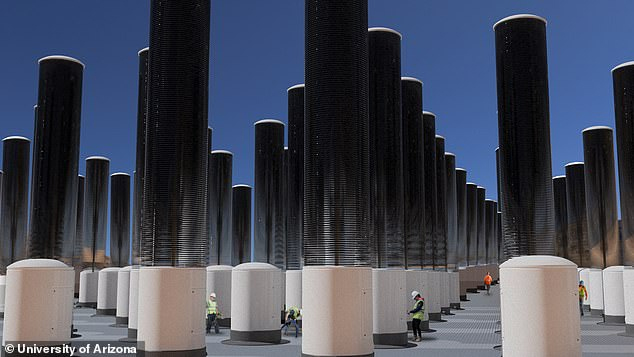Scientists affirm that “machine forests” have the ability to absorb CO2 from the atmosphere, helping to slow down the pace of climate change.
As the creator of this initiative, Professor Klaus Lackner from Arizona State University (USA) stated that the “machine trees” can absorb pollutants effectively thousands of times more than natural trees.

Simulation of a “machine forest” with stacked disk columns to absorb pollutants from the air. (Image: Daily Mail)
They are vertically standing disk columns. Each disk is 1.5 meters wide and spaced 5 cm apart. They are coated with a chemical plastic and stacked like a column of coal disks.
This type of plastic is designed to absorb CO2 from the air. After about 20 minutes of full absorption, they automatically drop into a container where the CO2 is separated and transferred to a sealed environment. They then continue the process of absorbing CO2 from the surroundings.
Currently, this model simply stores CO2, rather than converting it into oxygen like real trees or repurposing the carbon for other uses. However, according to the inventor, in the future, the CO2 that the “machine trees” store could be reused as synthetic fuels such as gasoline, diesel, or kerosene.
Mr. Lackner plans to build three large-scale “machine tree” farms, with the first project set to be launched in Arizona later this year, thanks to a $2.5 million investment from the Department of Energy. They are being designed and manufactured by the ASU Center for Negative Carbon Emissions.
When all three “forests” are operational, they will have the capacity to absorb 1,000 tons of CO2 per day, promising to be a significant step in reducing greenhouse gas emissions worldwide. Additionally, these “machine trees” can be easily installed anywhere needed, with a lifespan of up to several decades.
For over 200 years, since the Industrial Revolution, humanity has consumed fossil fuels in record amounts and emitted carbon into the atmosphere.
This is a potent greenhouse gas that enters the atmosphere at a rate faster than natural sources—such as trees—can remove it. As it accumulates in the atmosphere, it causes global warming.


















































